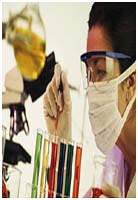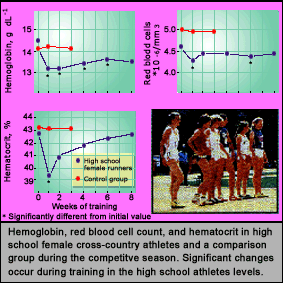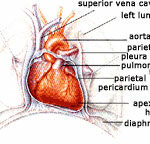Anemia has been identified as the most common medical condition among athletes. It is more common in females than males and especially in female athletes.
Anemia and iron deficiency
 The capacity of the body to transport oxygen is one of the factors which limits physical performance. Oxygen is transported in the blood by the pigment of the red blood cells (haemoglobin). If the concentration of haemoglobin is reduced, the oxygen-transporting capacity of the body is impaired, and therefore the capacity to perform drops.
The capacity of the body to transport oxygen is one of the factors which limits physical performance. Oxygen is transported in the blood by the pigment of the red blood cells (haemoglobin). If the concentration of haemoglobin is reduced, the oxygen-transporting capacity of the body is impaired, and therefore the capacity to perform drops.
Anemia is said to occur when the concentration of haemoglobin falls below that specified as normal for the individual’s age and sex. Athletes who subject themselves to prolonged, strenuous exertion (for example, by daily endurance training) may develop a degree of anemia.
Iron deficiency is the most common form of true anemia among athletes. Stores of iron are depleted before clinical signs show. Iron occurs in small quantities in the body, totaling about 1.5-1.75 oz (4-5g) in the adult. It is required not only for the manufacture of haemoglobin, but also for that of the related compound, myoglobin, found in muscle tissue. Both these substances bind oxygen and play an important role in its transport. Iron is mainly stored in haemoglobin(64%) and bone marrow(27%). Iron deficiency anemia is most prevalent among menstruating women and males between the age of 11 and 14.
Three conditions occur during anemia: erythrocytes (red blood cells) are too small, haemoglobin is decreased, and ferritin concentration is low. Ferritin is an iron-phosphorous-protein complex that normally contains 23% iron. There are many ways that athletes can be iron deficient. Gastrointestinal (GI) losses are common in runners because of bowel ischemia. Aspirin or non-steroidal anti-inflammatory drugs (NSAIDS) may cause cause GI blood loss. Runners absorb 16% of iron from the GI tract as compared with 30% in non-athletes who are iron deficient. Menstrual losses account for most iron loss in female athletes. Average menstrual iron loss is 0.6 to 1.5 mg per day. Inadequate dietary intake of iron is the primary cause of iron deficiency. The recommended daily allowance (RDA) is 15 mg per day for females and 10 mg per day for males. The average diet contains 5 to 7 mg or iron per 100 kcal. Because female athletes often eat less than they need, they also fail to consume enough iron. If the athlete is a vegetarian they may run the risk of lacking in iron.
Anemia can be confirmed by measuring the hemoglobin levels of the body. An iron deficiency can be identified by blood cell analysis and by determining the serum ferritin level and , if necessary, the amount of haemoisderin in the bone marrow. Young people store only small amounts of iron, and low serum ferritin levels are therefore normal in individuals under the age twenty. The examining doctor needs expert knowledge in order to be able to decide whether or not an apparent iron deficiency is really significant. On the whole, it is not most common for adults on a well-balanced diet to suffer from iron deficiency.
Symptoms and signs: In the first stages of iron deficiency, the athlete’s performance begins to decline. The athlete may complain of burning thighs and nauseas from becoming anaerobic. Ice craving is also common. Athletes with mild iron-deficiency anemia may have a slight drop off in maximum performance. Determining serum ferritin is the most accurate test of one’s iron levels. Two factors must be checked the sports doctor; the athlete’s mean corpuscular volume (MCV), which is the average volume of individual cells in cubic micron, and the relative sizes of the erythrocytes.
Control and treatment: The following are some ways to manage iron deficiency: ensure a proper balanced diet, including more red meat or dark poultry; avoid coffee and tea, as they effect iron absorption from grains; ingest Vitamin C sources, which enhance iron absorption; and take an iron supplement, consisting of ferrous sulphate 325 mg, check what the best amounts are for you with your doctor or pharmacist.
Footstrike Anemia, or hemolysis (destruction of red blood cells) :
Footstrike Anemia, or hemolysis (destruction of red blood cells), is secondary to iron deficiency in athletes.
The cause of footstrike anemia, is as it name implies, is the impact of the foot as it strikes the floor surface. Impact forces serve to destroy normal erythrocytes within the vascular system.
 Symptoms and signs: hemolysis is characterized by mildly enlarged red cells, an increase in circulatory reticulocytes, and a decrease in the concentration of haptoglobin, which is a glycoprotein bound to haemoglobin and released into the plasma. Even if the athlete wears a well-designed and well-constructed shoe, this condition can occur. Footstrike anemia varies according to the amount of running performed.
Symptoms and signs: hemolysis is characterized by mildly enlarged red cells, an increase in circulatory reticulocytes, and a decrease in the concentration of haptoglobin, which is a glycoprotein bound to haemoglobin and released into the plasma. Even if the athlete wears a well-designed and well-constructed shoe, this condition can occur. Footstrike anemia varies according to the amount of running performed.
Control and treatment: Footstrike anemia can be managed by running on soft surfaces wearing well-cushioned shoes and insoles, and running as lightly as possible on your feet.
Sickle Cell Anemia
Sickle cell anemia is a chronic hemolytic anemia. CORRECTION “Approximately 35% of the black population in the USA has this condition” The overall incidence is eight out of 100,000 people. However, it is more common in some populations, affecting one out of 600 African Americans and one out of 1,000 to 1,400 Hispanic Americans. Because people with sickle trait were more likely to survive malaria outbreaks in Africa than those with normal haemoglobin, it is believed that genetically aberrant haemoglobin evolved as a protection against malaria. Although this disease is inherited and present at birth, symptoms usually don’t occur until after 4 months of age.” source : http://www.nlm.nih.gov/medlineplus/ency/article/000527.htm
;8% to 13% are not anaemic but carry this trait in their genes. If both parents carry the defective gene, the child will have sickle cell trait. The person with sickle cell anaemia or trait can have siclemia. The person with the sickle cell trait may participate in sport and may never encounter problems until symptoms are brought on by some unusual circumstance.
In individuals with sickle cell anaemia the red cells are sickle or crescent shaped. Within the red cells, an abnormal type of hemoglobin exists. It has been speculated that the sickling of the red blood cells results from an adaptation to malaria, which is prevalent in some parts of Africa.
The sickle cell has less potential for transporting oxygen and is fragile when compared with normal cells. A sickle cell’s life span is 15 to 25 days, compared to 120 days of the normal red cell; due to this short life span severe anaemia can occur in individuals with sickle cell anemia. Due to the distorted shape of the cell, the passage through the small blood vessels is inhibited and cause the clustering of cells and consequently the clogging of the blood vessels, producing thrombi (blood clots that block small blood vessels or a cavity of the heart), which hinders circulation. Death (worst case scenario of sickle cell sufferers), can occur for individuals with this condition from a stroke, heart disease, or an embolus (a mass of undissolved matter) in the lungs. Conversely, persons with sickle cell anemia may never have any problems relating to their condition. Four factors of exercise can cause sickling: acidosis; hyperthermia, dehydration of red blood cells, increasing hemoglobin concentration; and severe hypoxemia.
Symptoms and signs: An athlete may never suffer any complications related to the sickle cell trait. However, a sickle cell crisis can be brought on by exposure to high altitudes or the overheating of the skin, as is the case with a high fever. Crisis symptoms include fever, severe fatigue, skin pallor, muscle weakness, and severe pain in the limbs and abdomen. Abdominal pain in the right upper quadrant may indicate a splenic syndrome syndrome in which there is an infarction. This is especially characteristic of a crisis triggered by flying at high altitudes. Headache and convulsions may also be experienced.
The treatment of a sickle cell crisis is usually symptomatic. The physician may elect to give anticoagulants and analgesics for pain.
View other articles of interest under the Sports Doctor section:
- When a bug strikes
- Exercise-induced anaphylaxis: ‘Why do I itch so badly?
- A run a day keeps you out of the doctor’s office
- Anemia and iron deficiency
- Runner’s Trots
- Bloody urine: Why?
- Human body – Heart and Lungs
- Upper Respiratory Infections
- Exercise and the Immune system
With more topics to be added.
Other Topics of interest :

























